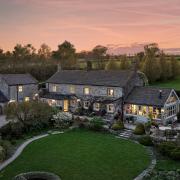People who live in this model village are keen to share its uniqueness, says Julie Hemmings. Photographs by Joan Russell

‘But you can go into the houses at Beamish,’ argue the puzzled visitors, slightly disbelieving that, unlike the outdoor heritage attraction in County Durham, people actually live in the model village of Saltaire in West Yorkshire and, no, they can’t just traipse through the middle of someone’s living room.
Visitors can look and marvel but not invade the homes of Saltaire created by industrialist Sir Titus Salt. The rows of cottages, church and hospital, built in the 19th century, helped to lift his employees out of slum living conditions which in turn created a healthier and happier workforce at Salts Mill, the textile mill on which he built his fortune.
The comparative comfort of homes in Saltaire and its well-planned amenities, surrounded by open space, contrasted with the nearby filth and squalor of Bradford’s slums. Sir Titus Salt may not have been the only Victorian businessman to realise creating better living conditions for his employees was a mutually beneficial set-up, but he seems to have exercised particularly comprehensive control over the concept.
His exacting aesthetic vision included details such as images of alpacas featured in glazing and stonework, to acknowledge the successful business opportunity he identified in converting the animals’ fleeces from a waste product into a soft fabric sought after by fashionable society.

He insisted the village be dry – no alcohol – to reduce the risk of bad behaviour. The larger homes of managers bookended the workers’ terraces, as if their charges needed to be reminded to stay in line. One unusual house has a glazed watchtower at roof level as a means of Victorian surveillance to ensure no one was where they shouldn’t be during the long working days.
Sir Titus not only named Saltaire after himself by combining his name with that of the river on which the village stands, he also named the streets after members of his family. But as a good upstanding citizen, he reserved the two main roads Victoria and Albert to honour his Queen and her Prince Consort.
After a long decline, the village’s post-industrial renaissance is credited to the similar drive and tenacity of a 20th century entrepreneur, Jonathan Silver, who transformed Salts Mill into a cultural and commercial hub which today is at the centre of much of the creative and economic life of Saltaire, which is also a UNESCO World Heritage Site.
Convenient transport links for commuters are among the reasons why the village remains a bustling community today - but it’s much more than a dormitory for Bradford and Leeds.

I’ve never been able to work out whether it’s the special nature of the place itself which attracts creative people with a sense of community, or if it is those people who’ve chosen to make their homes here that give the village its individual and distinct character. Whichever it is, whether recent incomers or members of longstanding village families, those who live here have a special affection for the place and they’re keen to share with others.
And in this spirit, the locals do sometimes let visitors traipse through their living rooms – and kitchens, yards and gardens – at special occasions during the year.
During Saltaire Inspired (May 28th-30th) people often turn their houses into art galleries, providing a backdrop for all kinds of works by talented locals, including glass, ceramics, paintings, prints and works in mixed media, as part of the festival’s Arts Trail.
During Saltaire Festival in September, residents open their yards and gardens to the public. As well as admiring the fruits of their green fingers, visitors can buy seeds and produce, and pick up gardening tips. In the past couple of years – and likely to happen this September - village gardens have hosted sculpture of all styles and sizes. This has been really popular and adds to the sense of exploration of the village, which can be a new experience even for those of us who live here.
In addition to the Open Gardens during Saltaire Festival, there have been a growing number of pop-up events in houses – we’ve had musical performances, a book exchange, beauty therapy, craft and vintage shops, coffee and tea shops and bakeries. Organisers are on the lookout for more open gardens and pop-ups; if you are interested in getting involved just email your ideas to info@saltairefestival.co.uk.
The biggest of these special occasions is Saltaire Festival, a ten day celebration of arts and community each September, around the date of Sir Titus’s birthday. The 2016 dates have been confirmed as September 9th-18th and more details of this year’s programme will be announced in the coming months. The festival will include celebrations to mark the 200th anniversary of the Leeds Liverpool Canal, as will the World Heritage Weekend, which takes place on April 16th and 17th.
For more details of the Saltaire Festival go to saltairefestival.co.uk. Leeds Liverpool Canal 200th anniversary go to canalrivertrust.org.uk. Saltaire Inspired Arts Trail go to saltaireinspired.org.uk/saltaire-arts-trail.



























